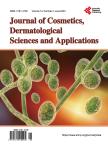Proteomic Alterations in Human Dermal Fibroblasts under Photo-Induced Pollution Caused by Excessive Solar Irradiations such as Infra-Red, Blue Light, UVA and UVB
Proteomic Alterations in Human Dermal Fibroblasts under Photo-Induced Pollution Caused by Excessive Solar Irradiations such as Infra-Red, Blue Light, UVA and UVB作者机构:ITC Life Sciences and Technology Center (ITC LSTC) Bangalore India
出 版 物:《Journal of Cosmetics, Dermatological Sciences and Applications》 (化妆品、皮肤病及应用期刊(英文))
年 卷 期:2023年第13卷第1期
页 面:16-32页
主 题:Full Light Technology Solar Irradiation Cellular Damage DNA Repair & Damage HDF Cells
摘 要:Background: The skin serves as the first line of defense for the human body. Direct sunlight contains damaging radiations that can speed up the ageing process of the skin, resulting in wrinkles, leathery skin, dark patches, and solar elastosis. Objectives: To evaluate the effect of multiple solar irradiation related factors at the protein level in human dermal fibroblast (HDF). The overall effect of individual solar irradiations such as Infrared A (IRA), blue light (BL), UVA, and UVB on HDF cells and the extent of molecular level aberrations to be assessed and compared against each. Methods: Label-free quantitative proteomics (MS/MS) approach has been adopted in this study to observe the protein level changes induced in the HDF cells through various exposures of full light sources. Following that, downstream insilico analysis has been carried out. Results: In this study, it is demonstrated all the four different solar irradiations significantly contribute to the molecular degeneration of skin cells through various mechanisms. This study confirms that BL down-regulates DNA repair proteins and the skin cells-HDF stimulate the histone proteins as a response mechanism to maintain the chromosomal integrity. Conclusions: The proteomics experiment carried out in the current study intends to support the future sun care products based on full light protection technology that can be custom designed to provide complete protection from the solar radiation. Similar technology could enhance the further investigations for deeper understanding of induction, mode of action, and prevention of skin damage from extensive solar irradiation.



